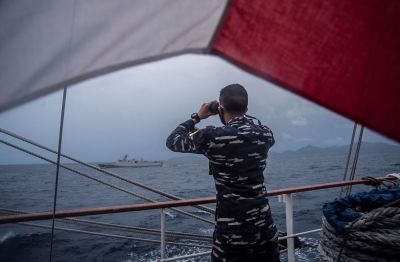The ASEAN Solidarity Exercise in Natuna 2023 (ASEX-01N), hosted by Indonesia in September 2023, was the first joint military exercise exclusive to the Association of Southeast Asian Nations (ASEAN). The exercise was called a major accomplishment as ASEAN member states considered to be “pro-Beijing” such as Cambodia attended.
This is not the first intra-ASEAN military drill held against a backdrop of tensions in the South China Sea. The ASEAN Multinational Naval Exercise (AMNEX) took place in Thailand in 2017, shortly after the South China Sea arbitration ruling. The second AMNEX was held in the Philippines in May 2023 amid renewed tensions between the Philippines and China.
AMNEX 2023 saw seven of 10 ASEAN member states contribute naval vessels — the Philippines, Brunei, Indonesia, Malaysia, Singapore, Thailand and Vietnam. Cambodia, Laos and Myanmar sent observers. Despite the exercise being held facing the South China Sea, no sensitivities over the disputes emerged that could hamstring the event.
Unlike AMNEX, which involves only ASEAN navies, ASEX-01N engaged armies, air forces and navies. Announcing plans for ASEX-01N in June 2023, commander of the Indonesian National Armed Forces Admiral Yudo Margono said he hoped the exercise, planned to take place in the North Natuna Sea, would strengthen ASEAN’s centrality and preserve regional stability.
Margono’s Cambodian counterpart, General Vong Pisen, later contradicted him — stating that the exercise was proposed by Indonesia when they were the ASEAN chair, but that Phnom Penh and several other ASEAN members did not respond. Cambodian defense authorities further claimed that all nine other ASEAN members had yet to respond to Margono’s announcement.
The core issue was the exercise location, as it involved the North Natuna Sea. This area includes Indonesia’s exclusive economic zone, which overlaps with Beijing’s “nine-dash line” claim. Cambodia and Myanmar were absent in the initial planning conference, likely to avoid provoking China.
Given the wariness of ASEAN member states, Indonesia shifted the location of ASEX-01N from the North Natuna Sea to areas that “include Batam and the waters of South Natuna”, with priority given to “areas that are prone to [natural] disasters” — especially the Lampa Strait and Sabang Mawang Island.

ASEX-01N involved five warships — two from Indonesia and one each from Brunei, Malaysia and Singapore. Indonesia also contributed air assets, while the remaining ASEAN countries and prospective new member Timor-Leste sent observers.
The Philippines and Vietnam did not send assets. This could be due to Manila’s limited capacity, given its earlier participation in training exercises with foreign partners, and the need to maintain assets in the South China Sea amid tensions with China.
Vietnam did not provide a reason for the absence of participating assets, though Hanoi may be balancing its South China Sea interests with maintaining ties with Beijing.
Indonesia emphasized the non-combat nature of the exercise, which included humanitarian assistance and disaster relief, search and rescue, and maritime security.
Margono avoided mentioning the South China Sea disputes during the ASEX-01N opening ceremony, instead stressing intra-ASEAN unity. But he later remarked that “those who carry out any exploration or activities in that area must not violate state territory.”
When asked if ASEAN was sending a stronger message against Beijing’s South China Sea claims, he replied, “we have had a firm stance”, adding that ASEAN has agreed to hold military exercises annually and future iterations will be expanded to full war drills involving the armies, navies and air forces of member states.
While ASEX-01N’s turnout was modest compared to AMNEX 2023, Margono’s remarks signal the potential for institutionalized and greater intramural participation. But the controversies leading up to the drill suggest it is difficult for an ASEAN member to use the exercise to push for its interests in the South China Sea.
The exercise is likely to be confined to non-traditional threat scenarios typically seen in pre-existing ASEAN-centric exercises. If Margono’s vision of future full war drills is to be realized, it is likely to include just a handful of ASEAN militaries, since members with closer ties to Beijing would refrain from meaningful participation.
There is also an often overlooked practical aspect. Upscaling joint training exercises requires resource and manpower commitments, which could strain ASEAN militaries’ limited capacities — especially in the context of economic and security challenges at home. ASEAN militaries have to be judicious in the exercises they choose to commit troops and assets to.
ASEX-01N symbolizes ASEAN’s commitment to strengthening the bloc’s centrality and represents a bold effort to promote tri-service joint military training beyond existing interactions.
To increase its prospects of institutionalization and expansion, future iterations of the exercise must contend with the expectations of individual ASEAN member states — meaning that future exercises will remain fraught with uncertainty.
Collin Koh is Senior Fellow at the S Rajaratnam School of International Studies, Nanyang Technological University, Singapore.
This article was originally published by East Asia Forum and is republished under a Creative Commons license.

